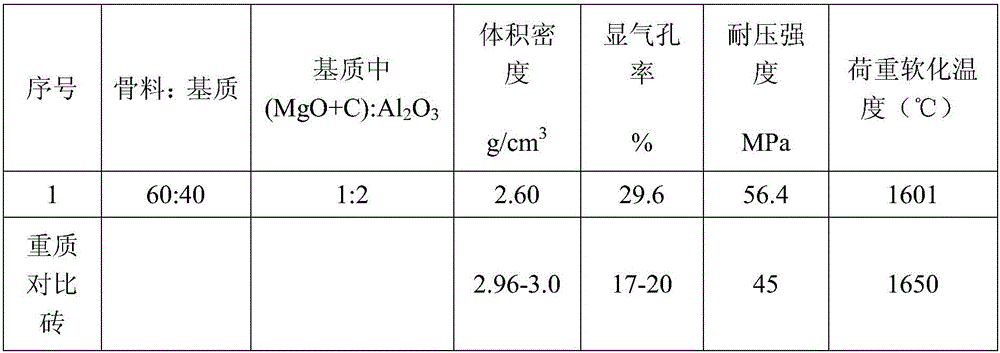Corundum-spinel light-weight refractory material and preparation method thereof
A refractory material and spinel technology, which is applied in the field of refractory material production, can solve the problems of affecting the service life and reducing the ability of castables to resist slag infiltration, and achieve the effect of high strength and high temperature performance
- Summary
- Abstract
- Description
- Claims
- Application Information
AI Technical Summary
Problems solved by technology
Method used
Image
Examples
preparation example Construction
[0021] This embodiment provides a method for preparing a corundum-spinel lightweight refractory material. The specific process includes the following steps:
[0022] Step 1: Select magnesia and carbon as the reaction raw materials, grind the raw materials to 180 mesh or below, mix them evenly according to the molar ratio of MgO and C at 1:1, and use them as pore-forming and reaction components in the fine powder in the refractory ingredients.
[0023] Step 2, batching the refractory raw materials according to a certain particle size distribution. The aggregate part can be tabular alumina, corundum lightweight aggregate or high alumina lightweight aggregate, or dense aggregate. The ratio of the aggregate part to the fine powder part is between 50-80:20-50, wherein the fine powder part contains MgO and C powder mixed in step 1. According to product requirements, the MgO and C powder account for the fine powder 20% to 70% of the powder part. In order to improve the uniformity a...
Embodiment 1
[0032] Mix 180 mesh fused magnesia and 180 mesh graphite evenly according to the molar ratio of MgO and C at 1:1. The tabular alumina of 1-3mm and the tabular grains of 0.1-1mm are used as coarse grains and medium grains respectively. Magnesia fine powder, graphite fine powder and alumina fine powder are used as the matrix part, and the ratio of coarse particles: medium particles: fine powder is 40:20:40. Among them, the ratio of the fine powder part of the alumina micropowder to the mixed powder of magnesium oxide and graphite is 2:1. Use phenolic resin ethylene glycol solution as a binder, and the addition amount is 8% of the total weight of the ingredients. After the ingredients are fully mixed, put them in an airtight container or plastic bag for 2 hours and then shape them on a hydraulic press. The molding pressure is 150MPa. The pressed sample is naturally cooled for half a day to 1 day, and then dried in the drying equipment with staged heating and heat preservation, a...
Embodiment 2
[0036]Mix 180 mesh sintered magnesia and 180 mesh graphite evenly according to the molar ratio of MgO and C at 1:1. 1-3mm and 0.1-1mm lightweight high-alumina particles are used as coarse particles and medium particles respectively. Magnesia fine powder, graphite fine powder and alumina fine powder are used as the matrix part, and the ratio of coarse particles: medium particles: fine powder is 40:20:40. Among them, the ratio of the fine powder part of the alumina micropowder to the mixed powder of magnesium oxide and graphite is 2:1. Use phenolic resin ethylene glycol solution as a binder, and the addition amount is 8% of the total weight of the ingredients. After the ingredients are fully mixed, put them in a closed container or plastic bag for 3 hours and then mold them on a hydraulic press. The molding pressure is 150MPa. The pressed sample is naturally cooled for half a day to 1 day, and then dried in the drying equipment with staged heating and heat preservation, and fin...
PUM
 Login to View More
Login to View More Abstract
Description
Claims
Application Information
 Login to View More
Login to View More - R&D Engineer
- R&D Manager
- IP Professional
- Industry Leading Data Capabilities
- Powerful AI technology
- Patent DNA Extraction
Browse by: Latest US Patents, China's latest patents, Technical Efficacy Thesaurus, Application Domain, Technology Topic, Popular Technical Reports.
© 2024 PatSnap. All rights reserved.Legal|Privacy policy|Modern Slavery Act Transparency Statement|Sitemap|About US| Contact US: help@patsnap.com










